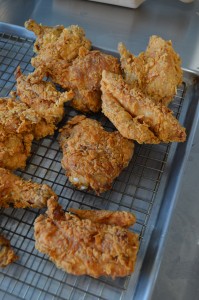 Usually I don’t post about something til I’m confident I have a best practice down pat. I have to say that there’s one important point in my fried chicken technique that I am waffling on: I’m torn between the winning flavour of buttermilk-brined chicken, and the superior texture of dry-rubbed chicken.
Usually I don’t post about something til I’m confident I have a best practice down pat. I have to say that there’s one important point in my fried chicken technique that I am waffling on: I’m torn between the winning flavour of buttermilk-brined chicken, and the superior texture of dry-rubbed chicken.
The Chicken. Frying chicken is a bit of a balancing act: you want the crust to develop the perfect, deep golden brown at the very instant the meat reaches the proper temperature. If you were to take an entire leg from a large chicken and deep fry it, the exterior would get much too dark by the time the meat cooked through.[1]
For this reason I like using smaller birds, somewhere around four pounds, and I cut them in the classic 8-cut style.
Brining vs. Dry-Rubbing. Once the bird has been cut there are two mains methods for marinating it. The first way that I learned is to submerge the chicken in buttermilk overnight. If given sufficient time, the tangy flavour of the buttermilk penetrates the flesh. It also supposedly tenderizes the meat, I think because of its acidity. The next day the chicken is dredged in flour and fried.
Many chefs expound the dry-rubbing method, in which the chicken is set out on a wire rack, sprinkled with salt and spices, and left uncovered in the fridge overnight. The salt works its way into the meat, and exposure to the dry, circulating air of the fridge supposedly makes for better skin. The next day the chicken is dipped in buttermilk and dredged in flour before frying.
This past weekend I tried these two methods side by side.
Dredging. I dredge in flour spiked with a bit of paprika and dried herb. I add only a tiny bit of salt to the flour because the brining and seasoning methods above have already made the chicken plenty salty.
Dredging should be done moments before dropping the chicken in the oil. Shake excess flour from the surface.
Frying. As always I will emphasize that you don’t need a deep-fryer to deep fry at home. Any straight-sided, heavy-bottomed pot or pan will do.
Fried chicken is cooked at a relatively low temperature. I heat the oil to 320°F. The cold chicken actually drops the oil temperature to 275°F or lower, and it will take several minutes to recover. Higher temperatures will darken the exterior before the meat cooks.
Even if the chicken is entirely covered in oil I flip all the pieces half way through as the downward-facing sides tend to brown faster.
Cooking takes roughly 15 minutes, depending of course on the size of your chicken bits. I use a temperature probe and pull all the breast meat at 70°C and all the leg meat at 80°C.
The Results: Buttermilk Brine v. Spice Rub
Some succinct tasting notes.
Buttermilk-brined chicken. Dark amber colour, actually a bit too dark. Crust not perfectly cohesive? Tangy, well-seasoned throughout.
Spice-rubbed chicken. Beautiful golden brown. Well-seasoned but perhaps not as thoroughly penetrated with salt? To me no detectable buttermilk tang, even with the dip before dredging.
No discernible difference in moisture content between the two styles.
They were both delicious, and I would be happy to serve and eat either. The visual difference was striking. Temperature was carefully controlled, so I figure that the extra milk sugars present in the buttermilk-brined chicken burnt. Also I think that the extra moisture on the brined chicken caused some of the dredging to slide off during frying.
More work is required obviously. Below is my dinner plate. The drumstick in the background is the spice-rubbed chicken. The thigh in the foreground the buttermilk version. Accompanied by garlic mash potatoes and green salad.
1. If you do find a piece of chicken getting too dark well before the meat is properly cooked, you can take the chicken out of the oil and put it on a wire rack on a sheet pan and hold it in a 250°F oven. The meat will continue to cook and the browning reaction at the surface will slow considerably.
